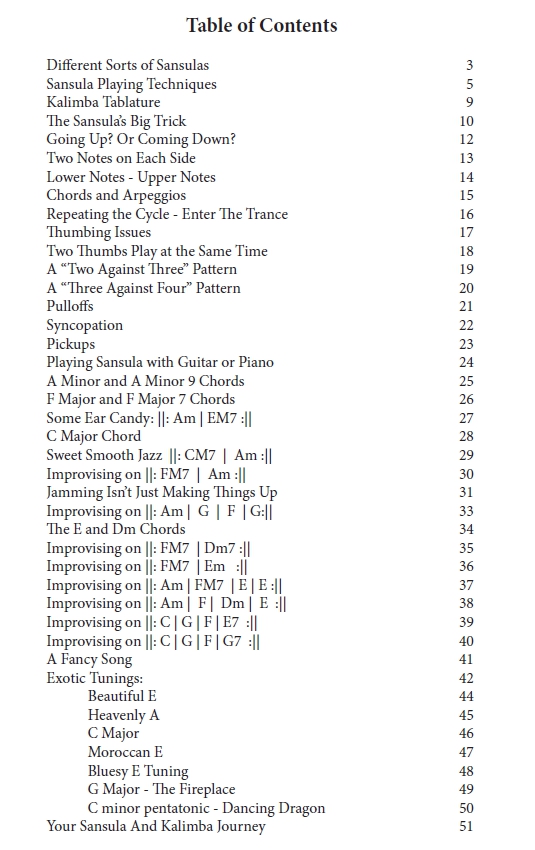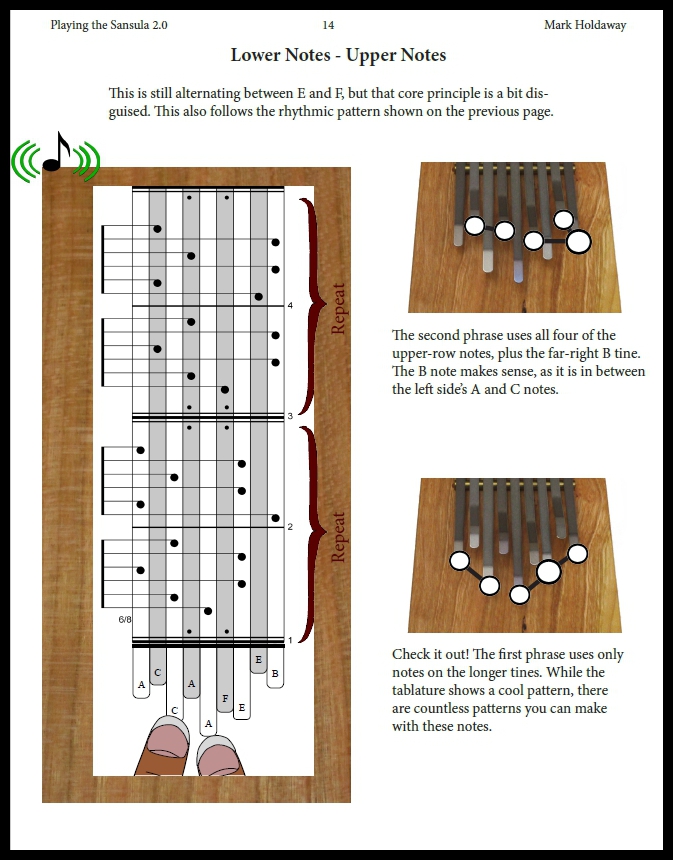
Use of this website constitutes acceptance of the Privacy Policy and User Agreement. Copyright © 2020 Kalimba Magic. All Rights Reserved.
The sansula is a wonderful, mysterious contradiction.
Whatever you play on the sansula sounds great…and the sansula also has a limited capability.
This download goes below the sweet, fluffy outer layer of the sansula’s character and gives you the understandings needed to really work the instrument’s potential, resulting in a lot more joy and music! Included in the ebook: the essential chord progression and melodies of the sansula in standard tuning; play along with surprisingly diverse chord progressions; accompanying another instrument; and alternative tunings – all these give you and your sansula a much wider scope of possibilities.
This ebook is a total rewrite of the 2009 book “Playing the Sansula.” The download is a 53-page PDF containing live links to 49 MP3 sound files and to web pages that can help you to understand how to read tablature or how to tune your sansula.

The sansula, in standard A minor tuning, naturally plays an enchanting chord progression that goes back and forth between Am and F. The astute observer will notice that Am is made of the notes A, C, and E, while F is made of F, A, and C – that is, 2/3 of the notes in Am are also in F, and vice versa.
This simple progression is embodied in the notes E (part of the Am chord) and F (right! part of the F chord). Going back and forth between E and F notes becomes shorthand for the Am / F chord progression.
The sansula sort of just does this one trick. A beautiful trick. And a pretty easy trick, so you have a high probability of success. But after a while, the sansula player may feel they are stuck in this Am / F bliss.
What to do when the Am / F bliss hits? There is a lot of nuance in that little instrument in your hands, and you might want to study what I have learned about the sansula.
First, there is a whole section that dives right into the Am / F bliss. You can do Am / F in 4/4 or 6/8. You can do it with a 2 against 3 pattern or a 3 against 4 pattern. You can do it syncopated.
You can play it with a fox, you can play it in a box.
This process will produce some good music, within the standard harmony. It will also build up your skills and confidence.
Next comes jamming with the guitar, which entails learning to play within and around chords. The sansula is so harmonically tilted toward the A minor that it has a very hard time doing anything else. There are several chords that cannot be played because they are missing 1, 2, or more notes. If a guitar plays those chords, the sansula can actually play along, even though the sansula cannot lead or define all the chords.
So, learning to play along with more complex chord progressions voiced by the guitar (or piano) is actually a really cool thing to do. You will learn how to improvise within this somewhat limited context.
The last section of the book is an introduction to alternative tunings. These are tunings that you yourself can likely put onto your sansula. Each of these tunings is a significant alternative to the standard A minor tuning, and each will have its own realm of music you can enter when playing in it.
At the very least, it is fun to hear or see what kind of music the various tunings can make. If you like the sound of some of those alternative tunings, it might be time to get your tuning chops rolling. They can all be yours, one at a time!
Below is an example page from the download:



Sign up for our newsletter and free resources with your email address:
We pinky promise not to spam you and to only send good stuff.
 Assist Paul Tracey Rebuild His House in Pacific Palisades
Assist Paul Tracey Rebuild His House in Pacific Palisades 8-Note Spiral Kalimba Turned into a Student Karimba
8-Note Spiral Kalimba Turned into a Student Karimba Seek to Infuse Your Musical Moments With Beauty and Magic
Seek to Infuse Your Musical Moments With Beauty and MagicUse of this website constitutes acceptance of the Privacy Policy and User Agreement. Copyright © 2020 Kalimba Magic. All Rights Reserved.